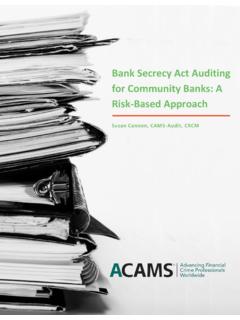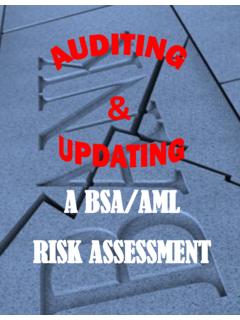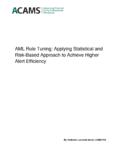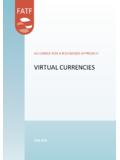Transcription of COMPARISON BETWEEN THE PROPOSED …
1 1 COMPARISON BETWEEN THE PROPOSED CHANGES TO THE 4TH MONEY LAUNDERING DIRECTIVE IN JULY 2016 AND THE PROPOSED CHANGES CONTAINED IN THE 5 AMLD AND OTHER PROPOSALS References: 5 AMLD: Council of the European Union Proposal for a Directive of the European Parliament and of the Council amending Directive (EU) 2015/849 on the prevention of the use of the financial system for the purposes of money laundering or terrorist financing and amending Directive 2009/101/EC - Presidency compromise text, 28 October 2016. Draft Opinion: Draft opinion prepared by the Rapporteur for the Committee on Legal Affairs prepared for the Committee on Economic and Monetary Affairs and the Committee on Civil Liberties, Justice and Home Affairs, November 2016.
2 Draft Report: Draft Report from the Committee on Economic and Monetary Affairs Committee on Civil Liberties, Justice and Home Affairs report on the proposal for a directive of the European Parliament and of the Council amending Directive (EU) 2015/849 on the prevention of the use of the financial system for the purposes of money laundering or terrorist financing and amending Directive 2009/101/EC, 7 November 2016. EESC: Opinion adopted by the European Economic and Social Committee, October 2016. July 2016: Reference to Draft report on the proposal for a directive of the European Parliament and of the Council amending Directive (EU) 2015/849 on the prevention of the use of the financial system for the purposes of money laundering or terrorist financing and amending Directive 2009/101/EC, Strasbourg 5 July 2016.
3 New or replacement text PROPOSED in the 5 AMLD is written in bold text; deleted text is written in strike-through text. My comments are in blue. 2 IMPLEMENTATION AS A WHOLE Given the huge importance of the fight against money laundering and in order to ensure that the rules in this field are implemented uniformly and effectively across all Member States, it is crucial that the texts and concepts that frame the PROPOSED measures be as clear as possible. (EESC) The Committee welcomes the rapid processing of these proposals and hopes that they can come into effect quickly and in the short term without detriment to the quality of the results.
4 A realistic timetable should be set out for the transposition and application of the legislation in the Member States and clear guidelines laid down. (EESC) Considering Financial Crime Risk In the Round The fight against money laundering should be linked more closely with the efforts needed to combat tax fraud and avoidance, corruption and other connected crimes. (EESC) Ensure that Changes Made Address Cooperation Challenges The fight against money laundering and the financing of terrorism require close cooperation BETWEEN the various intelligence and security public statements by national and European decision-makers and public support for closer cooperation, after every terrorist attack major failures of coordination come to light.
5 Every effort must be made to put an end to this situation. (EESC) 1. LIST OF HIGH RISK JURISDICTIONS The EESC has criticised the list of high-risk third countries, published by the European Commission on 14 July 2016 because it did not include many of the countries or jurisdictions believed to be acting as tax havens for money laundering, or any of the 21 territories mentioned in the Panama Papers. The EESC does not feel that the FATF list should be relied upon as the basis for this list. Given that the enhanced due diligence measures mentioned in 5 AMLD are applied only to third countries deemed to be high-risk, the EESC proposes that either a new list of high-risk third countries be drawn up, or the scope of the measures under Article 18a of 5 AMLD be broadened.
6 The EESC also proposes that a single list of jurisdictions that fail to cooperate in pursuing economic crime should be drawn up. The 5 AMLD amendments appear to have addressed some of the EESC s comments concerning Article 18a (See below). 3 2. APPLYING THE PRESSURE TO INFLUENCE OFFSHORE JURISDICTIONS The EESC has urged European institutions to strengthen their policies aimed at closing down tax havens. In particular, the EESC believes that all obligations PROPOSED in the 5 AMLD, especially those relating to the identification of the beneficial owners of bank accounts, businesses, trusts and transactions, should be extended to all territories or jurisdictions whose sovereignty resides with the Member States, including those which have special tax laws.
7 This is clearly aimed at European countries such as the UK, Luxembourg, Ireland and the Netherlands. The 5 AMLD amendments do not address the EESC s above concerns. 3. virtual currencies Changes Definition of virtual Currency Article 3 pt 18 New definition PROPOSED in July 2016 virtual currencies ' means a digital representation of value that is neither issued by a central bank or a public authority, nor necessarily attached to a fiat currency, but is accepted by natural or legal persons as a means of payment and can be transferred, stored or traded electronically. Amendments PROPOSED in the 5 AMLD ' virtual currencies ' means a digital representation of value that is neither issued by a central bank or a public authority, nor necessarily attached to a fiat currency, but is accepted by natural or legal persons as a means of payment and can be transferred, stored or traded electronically can be digitally transferred, stored or traded and functions as a medium of exchange, but does not have legal tender status in any jurisdiction and which is not funds as defined in point (25)
8 Of Article 4 of the Directive 2015/2366/EC nor monetary value stored on instruments exempted as specified in Article 3(k) and 3(l) of that Directive. 4. PREPAID CARDS Changes Recital 11 Purpose Behind Prepaid Card Thresholds New recital PROPOSED in July 2016 ..it is essential to lower the existing thresholds for general purpose anonymous prepaid cards and suppress the customer due diligence exemption for their online use. Amendments PROPOSED in the 5 AMLD ..it is essential to lower the existing thresholds for general purpose anonymous prepaid cards and suppress to limit the customer due diligence exemption for their online use.
9 4 Changes Recital 11 Purpose Behind Prepaid Card Thresholds Deletion PROPOSED - Draft Report Thus, while having due regard to consumers' needs in using general purpose prepaid instruments and not preventing the use of such instruments for promoting social and financial inclusion, it is essential to lower the existing thresholds for general purpose anonymous prepaid cards and suppress the customer due diligence exemption for their online use. The 5 AMLD amendments do not include this PROPOSED deletion. Changes Articles 12(1)(a) and (2) Grounds to Exclude Prepaid Card AML Requirements Additions PROPOSED in July 2016 (1)(a) A Member State may allow obliged entities not to apply certain customer due diligence measures with respect to electronic money, where all of the following risk- mitigating conditions are met: (a)the payment instrument is not reloadable, or has a maximum monthly payment transactions limit of EUR 150 which can be used only in that Member State.
10 (b) the maximum amount stored electronically does not exceed EUR 150 (2) Member States shall ensure that the derogation provided for in paragraph 1 is not applicable in the case either of online payment or of redemption in cash or cash withdrawal of the monetary value of the electronic money where the amount redeemed exceeds EUR 50. Amendments PROPOSED in the 5 AMLD (1)(a) no PROPOSED changes. (2) Member states shall ensure that the derogation provide for in paragraph 1 is not applicable in the case of either online payment or of redemption of cash or cash withdrawal of the monetary value of the electronic money where the amount redeemed exceeds EU50 or remote payment transactions as defined in point (6) of Article 4 of the Directive 2015/2366/EC where the amount paid exceeds EUR 50 and as from the date of entry into force of this directive + 24 months for all remote payment transactions.












